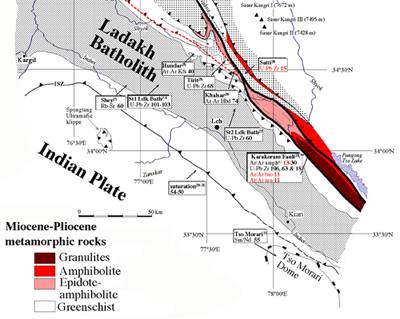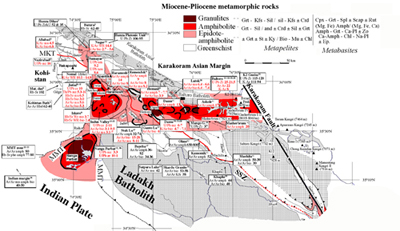The NW Syntaxis is made up of oceanic units (Kohistan-Ladakh) amalgamated between the Indian and Asian (Karakoram) continental margins. The Kohistan-Ladakh terrane is characterised by remnants of intra-oceanic arc magmatic rocks (Fig. 2) formed during Middle Cretaceous times. These magmatic rocks range in age from 110 to 90 Ma, based on radiometric data obtained both in Ladakh (Honegger et al., 1982; Schärer et al., 1984) and Kohistan (Treloar et al., 1989; Mikoshiba et al., 1999; Schältegger et al., 2000) and from palaeontological data (Desio, 1974; Tahirkeli, 1982; Dietrich et al., 1983; Pudsey, 1986; Reuber, 1989). These oceanic terranes are mainly remnants of arc-series reflecting intra-oceanic subduction of the Neo-Tethys. Different interpretations have been proposed for the polarity of subduction; north-dipping along the southern margin of the Asian continent (e.g., Tahirkeli et al., 1979; Bard et al., 1980; Honegger et al., 1982; Dietrich et al., 1983; Reuber, 1989; Khan et al., 1989; 1993; Petterson & Windley, 1991; Treloar et al., 1996), or south-dipping along the northern side of the Indian continent (Reynolds et al., 1983; Khan et al., 1997).
Figure 2. Geological sketch map of the NW Himalaya-Karakoram region

1, area investigated in Ladakh-Karakoram geological areas (Skardu, Pakistan); 2, area investigated in Ladakh and Karakoram Fault areas (Leh, NW India).
These terranes were subsequently accreted to the Asian margin during the Late Cretaceous (80 to 88 Ma, Petterson & Windley, 1985, Weinberg et al., 2000), along the Shyok (or Northern) Suture Zone (SSZ, Fig. 2), which separates them from the Karakoram margin of Asia, as summarised below. In Kohistan, this northern suture was reactivated along an out-of-sequence thrust: the Main Karakoram Thrust (MKT; Pudsey, 1986). Between 65 and 55 Ma, during the initial phase of the India–Asia continental collision, the Kohistan-Ladakh Arc was obducted onto the Indian margin along the Main Mantle Thrust (MMT, Tahirkheli et al., 1979), or Southern Suture, which is believed to be the western prolongation of the Indus-Tsangpo suture zone in Tibet. South of the MMT, southwards thrusting in the Indian margin gave rise to the Himalayan chain (e.g., Treloar and Rex, 1990). North of the Shyok suture, thickening of the Asian margin gave rise to the Karakoram Range. The central part of the Karakoram terrane is comprised of the NW-SE striking composite calc-alkaline Karakoram Batholith, emplaced between 120 and 88 Ma in response to northwards subduction of Tethyan oceanic crust (Debon et al., 1987; Searle et al, 1989). Between 80 and 37 Ma (M1 event), collision of the Karakoram terrane with the Kohistan-Ladakh terrane, and subsequently with India, has produced SW-directed nappe stacking and Barrovian-type metamorphism (Bertrand et al., 1988; Searle et al., 1989; Hanson, 1989; Allen & Chamberlain, 1991; Lemennicier et al., 1996; Rolland et al., 2001). This M1 event is characterised by NW-SE foliation and metamorphic isograds ranging from lower greenschist in the SW to amphibolite facies in the NE.
The Miocene to Pliocene evolution of the NW Syntaxis is characterised by intense deformation, metamorphism and magmatism, in particular in the Nanga Parbat-Haramosh (NPH) massif, in the Southern Karakoram margin and along the Karakoram Fault (Figs. 2-3).
Figure 3. Repartition of radiochronological ages with respect to metamorphic grade in the NW syntaxis (A, Pakistan side; B, Indian side)

Ages written in red are less than 25 Ma. Note the good correspondence between young ages and high grade metamorphism. Abbreviations used: ISZ: Indus Suture Zone; MMT: Main Mantle Thrust; MKT: Main Karakoram Thrust; amph: amphibole; and: andalusite; bio: biotite; Cord: cordierite; Ep: epidote; Grt: garnet; Scap: scapolite; Sil: sillimanite; Spl: spinel; Kfs: K-feldspar; mu: muscovite; mz: monazite; phe: phengite; pl: plagioclase; sp: sphene; St: staurolite; ura: uraninite; WR: whole-rock; xen: xenotime; Zo: zoisite; Zr: zircon. References cited: 1: Debon (1995); 2: Fraser et al. (2001); 3: Le Fort et al.. (1983), 4: Villa et al. (1996a); 5: Treloar et al. (1989); 6: Petterson & Windley (1985); 7: Honegger et al. (1982); 8: Schärer et al. (1984); 9: George et al. (1995); 10: Schneider et al. (1997); 11: Debon et al. (1987); 12: Zeitler & Williams (1988); 13: Zeitler et al. (1993); 14: Smith (1993); 15: Smith et al. (1992); 16: Schärer et al. (1990); 17: Villa et al. (1996b); 18: Parrish and Tirrul (1989); 19: Debon et al. (1986); 20: Searle et al. (1989); 21: Searle et al. (1990a); 22: Treloar et al. (1991); 23: Brookfield and Reynolds (1981); 24: Reynolds et al. (1983); 25: Honegger (1983); 26: Weinberg et al. (2000); 27: Weinberg & Dunlap (2000); 28: Searle et al. (1998); 29: Garzanti and Van Haver (1988); 30: Searle et al. (1990b); 31: de Sigoyer et al. (2000); 32: Maluski and Matte (1984); 33: Ancziewicz et al. (1998); 34: Treloar and Rex (1990); 35: Maluski and Schaëffer (1982); 36: Zeitler (1985); 37: Zeitler and Chamberlain (1991); 38-39: Smith et al. (1992, 1994); 40: Winslow et al. (1996); 41: Rolland (2000); 42: Rolland et al. (accepted).
The NPH massif is a N-S elongated structural window of Indian crust uplifted through its Kohistan-Ladakh cover. In this window, elevations are very high, locally over than 8000 m (Nanga Parbat), in contrast with the main part of the NW Himalayan chain. These elevations coincide precisely with young plutonic and high-grade rocks (10-1 Ma, U-Pb on zircon, Zeitler et al., 1993; Chamberlain and Zeitler, 1996, Schneider et al., 1997; 2001), suggesting very high uplift rates of up to 7 mm yr-1 (Zeitler et al., 1982; 1993). The NPH spur is regarded as a huge transverse anticline produced by shortening parallel to the strike of the belt, in response to deformation partitioning related to oblique India-Asia convergence (Seeber and Pêcher, 1998; Treloar et al., 1991).
In the Karakoram margin, the previously described M1 structures are crosscut by post-20 Ma (M2) structural, metamorphic and magmatic features. The NW-SE foliation is crosscut by the Mango Gusor granite dated at c. 37 Ma, and by the W-E striking, Baltoro granite dated at 21-25 Ma (U-Pb on zircon by Parrish and Tirrul, 1989; Schärer et al., 1990). M2 metamorphic peak temperature and subsequent doming coincided with granitic intrusions which have occurred all along the southern part of the Karakoram Terrane (e.g. Aliabad granite, 6.8 Ma, K-Ar on biotite, Le Fort et al., 1983, Sumayar granite, 9.2 Ma, U-Pb ages on uraninite, Fraser et al., 2001). This magmatism is K-rich and mantle derived (see a review of geochemical data in Mahéo et al., 2002). Magmatic advection has triggered migmatisation by mica dehydration melting reactions (Rolland et al., 2001). Subsequently, these softened mid-crustal-layers, in the core of an E-W trending fold structure, produced doming by local diapric amplifications. In the whole dome area, M2 is well documented with U-Pb monazite ages at 6-7 Ma in the Dassu Dome, and with cooling ages ranging from 10 to 3 Ma (see Rolland et al., 2001 for a review). Similarly to the NPH massif, these young metamorphic rocks suggest rapid uplift (3 mm.yr-1) of the Karakoram massif. There are, however, several differences regarding the styles of metamorphism in these two zones (NPH and Karakoram). These differences are emphasised by the shape of the P-T paths, which is mainly adiabatic in the NPH massif and convex towards HT for the Karakoram. These differences in shape may relate to different tectonic causes for HT metamorphism.
East of the Karakoram terrane, the 1000-km long Karakoram Fault separates the Karakoram-Ladakh-Indian accreted terranes from the Lhasa-Qiantang blocks (Figs. 1-2). The Karakoram Fault is a dextral shear zone, trending 140°E. It reactivates former sutures between the tectonic blocs, branching in the NW into Pamir thrusts and strike-slip faults to and to the SE into the Shyok and Indus-Tsangpo sutures (e.g., Armijo & Tapponnier, 1989; Matte et al., 1996). The magnitudes of right lateral offset and slip rate and the duration of slip of the Karakoram strike-slip fault are debated. Peltzer & Tapponnier (1988) have estimated a large offset (1000 km), based on correlation of the Ladakh and Gangdese batholiths, and this has led to an estimate of elevated slip rates of 32 mm yr-1, also suggested by the offset of topographical features (Liu et al., 1992; Liu, 1993). In contrast, Searle (1996) and Searle et al. (1999) have proposed a smaller offset estimate (120 km), from the correlation of the Baltoro and Tangtse granites and Shyok and Bangong Sutures in the central part of the fault. In the SE segment of the fault, Murphy et al. (2000) have estimated a post-13 Ma offset of 66 km of the Kailas Thrust. The Pangong Range, exhumed within the central part of the Karakoram Fault, provides several constraints on the time of strike-slip shearing. The Pangong Range is a 100 km long – 5 to 10 km wide massif, exhumed between two branches of the fault (Fig. 2; Rolland & Pêcher, 2001), and is comprised of two tectonic units: a central granulitic core and an amphibolitic rim. The presence of granulites exhumed within the fault zone suggests a high thermal gradient, interpreted as thermal advection within a lithosphere-scale fault (Rolland & Pêcher, 2001).
Further discussion on the magnitude of lateral offset of the fault, based on the exhumation history of the Pangong Range and on other geological evidence, is presented below.
